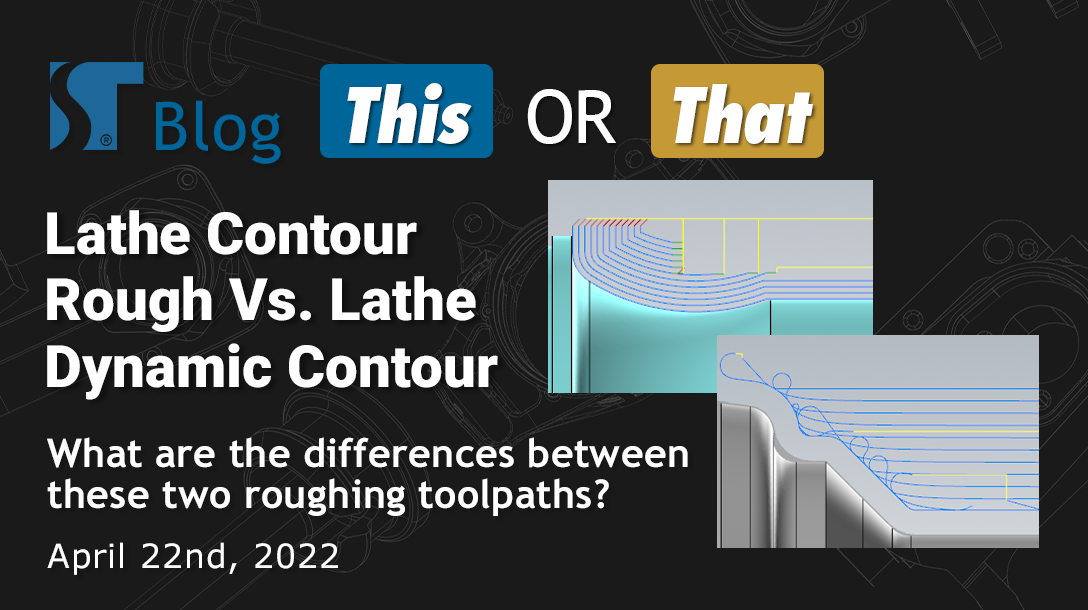
This or That: Lathe Contour Rough Vs. Lathe Dynamic Contour
The decision to use Lathe Contour Rough or Lathe Dynamic Roughing depends on the shape of your tool and your access to the stock.
By John Stauffer and Callie Morgan
Friday, April 22nd, 2022, 10:00 AM PDT
If you’re familiar with Dynamic Milling, you might have seen Lathe Dynamic Roughing and tried it, only to find that it didn’t really work for you. Most would end up switching to Lathe Contour Rough instead because it seems to work well out of the box. But when is Lathe Dynamic Rough right for the job? We’ll explain the differences between these two roughing toolpaths.
Lathe Contour Rough (LCR)
Lathe Contour Rough (we’ll call it LCR) is a simple toolpath. Essentially, what LCR does is take the profile that you want to cut and create offset passes from that profile out to the stock. It will trim off any moves that do not cut stock, so you are left with a path that cuts stock on every pass, following the same profile as the part. The offsets can be set as constant (matching in X and Z) or you can set the offsets differently for X and Z.

This toolpath has flexibility on which tool you want to use as well. You can use any insert for this toolpath, as long as the tool has the clearance needed to get down to the features. This toolpath does support zig-zag cutting, but most inserts are not designed to zig-zag cut, so this option is usually left off unless you are using a round tool.

Due to the way LCR offsets the profile, this toolpath is useful for roughing, but it’s even better at semi-finishing in harder-to-reach areas. Generally, this is a great cleanup tool to use just before finishing when you have more complex geometry and tricky sections to navigate. You can think about it as a multipass finish toolpath that leaves stock, but only cuts where stock remains from previous roughing operations.
This toolpath does have a tendency to create short cuts in areas you may not expect or desire, as seen in the video above. It’s not particularly efficient at general roughing in most geometry due to how often it tends to retract and reposition for the next depth cut. Because LCR is offsetting from the geometry, it tends to create cuts in the middle of the stock and move out to the front and back faces of standard cylindrical stock, as seen in the first video. This toolpath works very nicely when used with cast or forged stock since it typically follows a similar profile to the finished part.
Lathe Dynamic Roughing (LDR)
Utilizing Mastercam’s Dynamic Motion technology, Lathe Dynamic Roughing (we’ll call it LDR) is designed to machine the part more efficiently with increased cutting speed, while minimizing localized wear on the tool by keeping it engaged in the material more consistently.
Unlike LCR, LDR can only use round tools. This allows the toolpath to create smooth entry and exit moves for each pass, easing the tool into the cut, much like Dynamic Milling does. Not only does this make for improved tool life, but it also reduces sudden changes in cutting pressure against the part. Additionally, round tools can generally get more effective cutting edges per insert than other shapes of tool inserts because they can be rotated incrementally to get the maximum life out of them.
LDR does support zig-zag cutting motion, and since it is limited to round tools, it is actually quite useful. Zig-zag cutting allows for cut motion from front to back and back to front (moves from negative to positive Z and vice versa), which means less time repositioning between cuts. If you do use the zig-zag motion, just be sure that you have sufficient clamping pressure to hold the part in the chuck, as moving from back to front can cause the material to pull out of the jaws. If you prefer to stick to one-way cutting, that is supported as well.
Comparing LCR and LDR
These two videos compare LCR and LDR using the same tool and stepover on the same part. Notice the smooth motion, entry, and exit of LDR (top).

Compare with LCR, which also makes a usable toolpath, but with sharp corners mid-cut and a less elegant entry and exit move. Notice where the cuts begin between the two, with LDR covering the entire part from front to back at the beginning, and LCR moving from the center outward.

When to Use LCR
Use LCR for semi-finishing in harder-to-reach areas of a part. LCR can be used with many shapes of inserts, as long as you have the clearance to reach the features you are trying to cut.
When To Use LDR
Use LDR for general-purpose roughing with round tools, particularly when you have great clamping or tailstock support. Parts with a narrow “waist” also benefit from LDR.
For access to more in-depth Mastercam training content, sign up for a Streamingteacher account here!
Follow Us!
Facebook: https://www.facebook.com/Streamingteacher
LinkedIn: https://www.linkedin.com/company/streamingteacher/
Twitter: https://twitter.com/Streamingteach